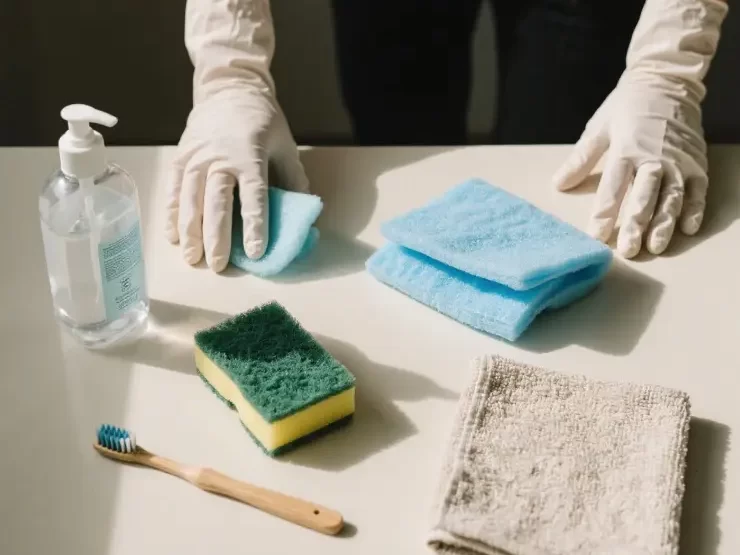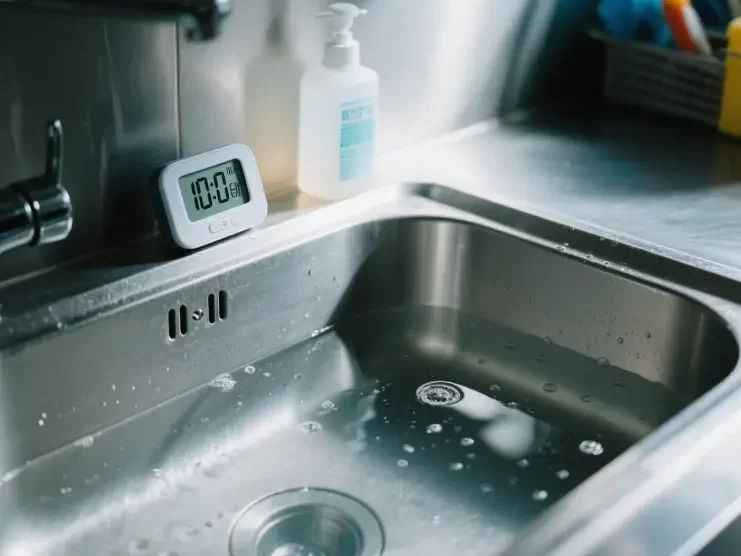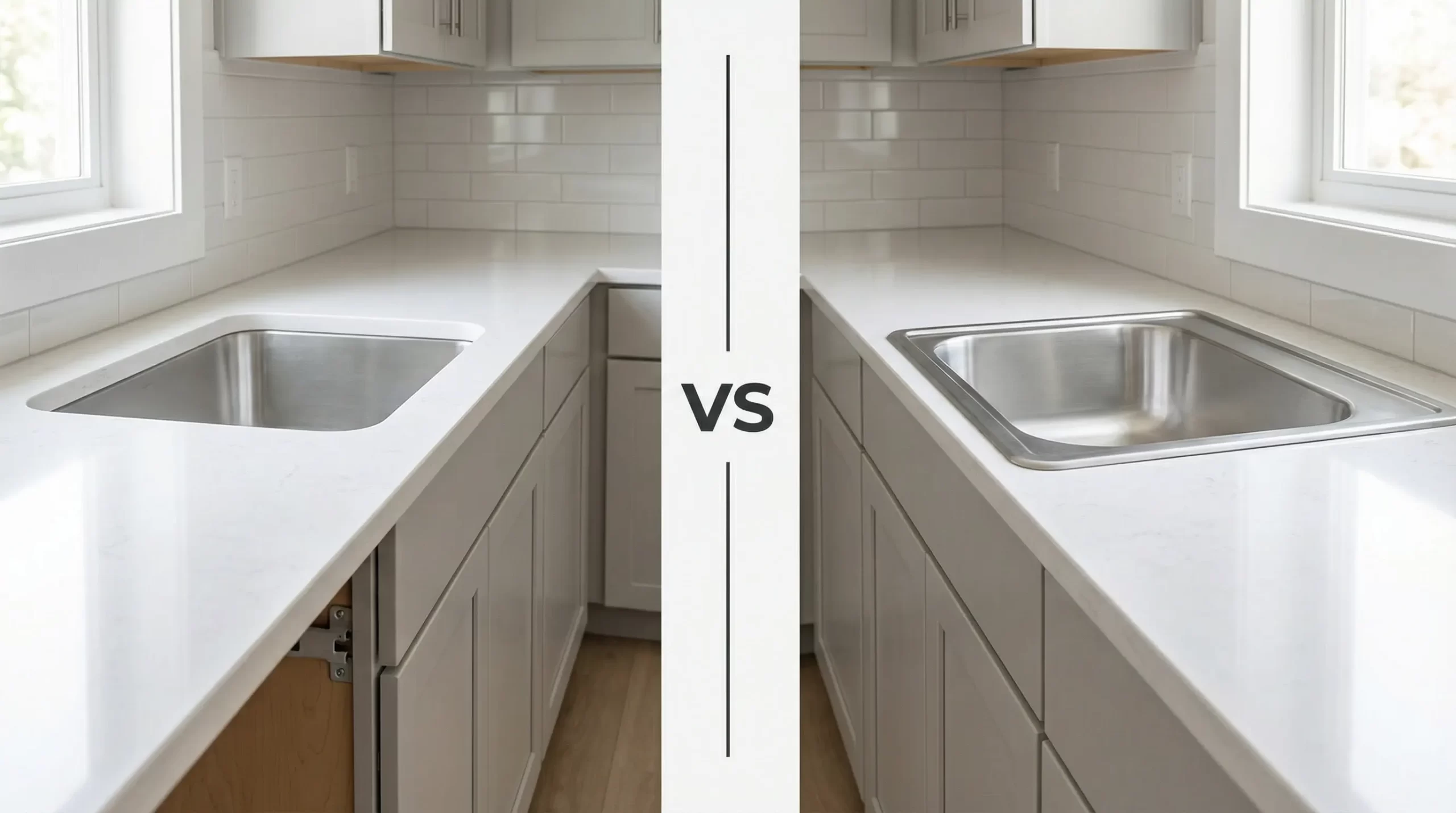How Do You Clean a Stainless Steel Laundry Sink
Keeping your stainless steel laundry sink sparkling isn’t rocket science. Here’s a quick, no-fuss way to get it done:
- Blast your laundry sink with 140°F (60°C) hot water for 5 minutes to loosen up grime.
- Grab a sponge, dip it in citric acid (or white vinegar), and scrub away soap scum and limescale.
- Use an old toothbrush to tackle the drain and seams—get rid of that stubborn gunk.
- Spray a diluted disinfectant (like 1:100 bleach water), let it sit for 10 minutes, then rinse it off to kill germs and keep things fresh.
- Wipe it dry with a clean rag and rub on a little oil to keep your sink shiny and happy.
Why Bother Cleaning Your Laundry Sink Regularly?
1. Kick Stubborn Stains and Buildup to the Curb
Every time you use your laundry sink to wash clothes, soap, lint, and hard water leave their mark. Check out what piles up:
- Soap Scum: Detergent and hard water team up to form a sticky mess—about a tablespoon builds up on the sink surface every month.
- Bacteria and Slime: Wet sink corners turn into a slippery “biofilm” party in just 72 hours if you don’t clean them.
- Limescale: In hard water areas, limescale can get as thick as a strand of hair each month.
Studies say an uncleaned laundry sink can harbor 200 times more bacteria than a toilet seat—think E. coli hiding out. Regular cleaning keeps it fresh and functional.
2. Stop Rust and Damage Before It Starts
Your stainless steel sink has a protective layer to fight rust, but it’s not invincible:
- Harsh alkaline detergents (like concentrated laundry soap) wear that layer down over time.
- High-chlorine water near the coast can leave tiny pits on the sink surface.
- Scrubbing with a rough brush scratches your laundry sink, letting rust sneak in.
With good sink maintenance, your laundry sink can last 8-10 extra years and still look shiny as heck.
3. Avoid Cross-Contamination Drama
A dirty laundry sink isn’t just an eyesore—it’s a health hazard:
- Bacteria Spread: A wet rag can carry sink germs to your dishes or countertops, upsetting your stomach.
- Mold Growth: Damp sink corners sprout mold, sending spores into the air that make you sneeze or itch.
- Skin Issues: Washing baby clothes in a grimy sink might pick up staph bacteria, leading to rashes.
The CDC says 22% of home infections are tied to dirty sinks. For families with kids or allergies, keeping your laundry sink clean is a big deal.
Step-by-Step Guide to Cleaning Your Laundry Sink
1. Gear Up Like a Pro
Before you dive in, set yourself up:
- Gear: Slip on rubber gloves to protect your hands. Strong cleaners? Add a mask.
- Tools: Grab a sponge, an old toothbrush, and a dry rag. Wipe them down with rubbing alcohol first for a clean start.
- Water: In hard water zones (where limescale’s a pain), use bottled or boiled water for better stain removal.
- Airflow: Crack a window or flip on a fan—good ventilation makes it a breeze.

2. Pick the Right Cleaning Stuff
Match your cleaner to the mess:
- Soap Scum: Mix 5% citric acid (from the store) with 140°F water to melt detergent buildup. No citric acid? Warm white vinegar works too.
- Limescale: Brush on 3% sulfamic acid (hardware store find) to soften it fast, or soak with vinegar for 15 minutes.
- Germs: Use 5% sodium percarbonate (a bleach alternative) in warm water to kill bacteria and stains. Otherwise, diluted bleach (1:100 with water) keeps your sink sanitary.
Pro Tip: Don’t mix acidic cleaners (like vinegar) with alkaline ones (like bleach)—they cancel each other out.
3. Deep Clean Every Nook
Here’s how to hit every spot:
- Step 1: Preheat
- Run 140°F water over your laundry sink for 5 minutes to soften tough stains. Pop a small strainer in the drain to catch debris.
- Step 2: Smart Scrubbing
- Dip a sponge in cleaner and scrub along the stainless steel sink’s grain (no random swipes, or you’ll see marks). Focus on these hot spots:
- Drain: Dig in with a toothbrush to clear hair and sludge.
- Seams: Use a Q-tip with cleaner to get them spotless.
- Faucet Base: Unscrew the filter and give it a quick brush.
- Dip a sponge in cleaner and scrub along the stainless steel sink’s grain (no random swipes, or you’ll see marks). Focus on these hot spots:
- Step 3: Disinfect
- Spray diluted disinfectant (like store-bought chlorine dioxide or bleach), wait 10 minutes, then rinse. Germs are toast, and your laundry sink’s clean.
4. Finish with Sink TLC
- Dry It: Wipe your laundry sink with a dry rag—no water spots, just shine.
- Protect It: Dab on some olive oil or stainless steel polish (from the hardware store) to fend off stains and rust.
- Bonus: Rub in a bit of baby oil, and water beads will slide right off.

Quick Laundry Sink Cleanup
Short on time? Try this daily sink maintenance trick:
- Rinse your laundry sink with hot water for 2 minutes.
- Scrub with dish soap and a sponge.
- Rinse again and wipe dry with a rag.
Five minutes, and you’re good—perfect for busy days!
Handy Laundry Sink Cleaning Hacks
- Steam Blast: Got a steam cleaner? Hit it with 265°F (130°C) steam—germs and stains vanish.
- Fast Dry: Wipe your laundry sink right after use; dry it in 15 minutes, and limescale won’t stick.
- Rust Fix: Rub brown spots with toothpaste for 2 minutes—stain removal made easy.
- Mold Block: In humid weather, toss a small desiccant pack near your sink to keep mold at bay.
Sink Maintenance Do’s and Don’ts
- Don’t: Skip the steel wool—it scratches your stainless steel sink and invites rust.
- Do: Limit acidic cleaners (vinegar, citric acid) to once a week, no soaking past 30 minutes.
- Do: Check the drain monthly—flush it with hot water and soap.
- How Often:
- Regular homes: Wipe daily, deep clean weekly.
- Kids or allergies: Wipe twice daily, deep clean twice weekly.
- Hard water areas: Wipe twice daily, scrub 3-4 times a week.
Common Laundry Sink Problems & Fixes
Problem: Rust Spots Popping Up?
- Why: Could be iron bits (from pots or brushes) sticking to the sink surface, causing “fake rust” (not the steel itself).
- Fix: Rub toothpaste with a splash of water on it for 2 minutes, or dab 10% oxalic acid (pharmacy buy) on the spot, wait 2 minutes, and rinse.
- Prevent: Keep iron stuff (pots, screws) off your laundry sink, and ditch steel wool for cleaning.
Problem: Still Smells Funky After Cleaning?
- Why: Odors usually come from drain gunk, food scraps, or bacteria thriving in dampness.
- Fix: Flush the drain with 140°F water and a spoonful of baking soda, wait 5 minutes, then add a few drops of lemon juice or vinegar. Stubborn stink? Pour half a cup of diluted bleach (1:100), let it sit 10 minutes, and rinse.
- Prevent: Clear drain hair and debris after each use, flush weekly with hot water, and toss a dehumidifier pouch nearby in humid months.
Problem: How Do I Pick Safe Cleaners?
- Why: Some cleaners are harsh or leave residue, especially in a laundry sink where clothes get washed.
- Fix: Grab “food-grade” or “eco-friendly” stuff from the store—think dish soap, citric acid powder, or disinfectant. If it stinks too strong, skip it.
- Tip: Go for natural options (vinegar, baking soda) or check for safety logos (FDA, NSF). Rinse extra well after to ditch any leftovers.






